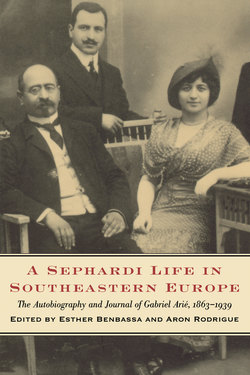Читать книгу A Sephardi Life in Southeastern Europe - Aron Rodrigue - Страница 8
На сайте Литреса книга снята с продажи.
ОглавлениеPreface to the English Edition
This is a slightly revised version, in translation, of a book that appeared in Paris in 1992 under the title Un vie judéo-espagnole à l’Est: Gabriel Arié (1863–1939). It contains the autobiography, journal, and selections from the correspondence of Gabriel Arié. Arié was born in Bulgaria in the last years of Ottoman rule, was educated by and became a teacher and major actor in the Alliance Israélite Universelle, the foremost Jewish organization of the time, and created and directed important Jewish schools and institutions in Ottoman Turkey. Upon his return to Bulgaria after ending his teaching career because of tuberculosis, Arié went on to become a successful businessman and an important notable and participant in Jewish politics. He also wrote most of the two volumes of the official history of the Alliance, Cinquante ans d’histoire, which appeared in print under the authorship of the organization’s president, Narcisse Leven, and which was until recently the definitive history of the diplomatic and educational work of the institution. He also published a history of the Jews, Histoire juive depuis les origines jusqu’à nos jours (1923), which was adopted as a textbook for Jewish schools in France until World War II.
The public work and activities of this Sephardi figure became familiar to us as we conducted research in the archives of the Alliance for a variety of projects over the years. It was by chance that Aron Rodrigue’s De l’instruction à l’émancipation caught the eye of Gabriel Arié’s grandson Dr. Elie Arié of Paris, who contacted him to reveal that he was in possession of his grandfather’s autobiographical manuscripts. Writings of this kind are quite rare in the Judeo-Spanish world, and this provided us with a unique opportunity to publish and to analyze both the public and the private lives of one of its important personalities. Together with selections from his letters to the Alliance Central Committee about a variety of political and educational matters, Arié’s writings provide a special perspective on the political, economic, and cultural changes undergone by the eastern Sephardi community, in the decades before its dissolution, in regions where it had been constituted since the expulsion from Spain in 1492. They also offer insight into these changes from the unique vantage point of an individual life and throw light on representations of the self by one of the members of the first generation of Westernizing Sephardim.
Arié’s writings are organized into two parts in this book. Part I contains the autobiography that he wrote in 1906, when he thought that he would not survive tuberculosis, and a selection from his correspondence to the Alliance up till that year. Part II presents the yearly journal entries that he made to the manuscript after this period until his death, again accompanied by a selection of his letters.
The publication of this book would not have been possible without Gabriel Arié’s son Narcisse Arié and his grandson Dr. Elie Arié, who provided us with the manuscripts of the autobiography and the journal, with the photographs and the genealogical data, and with all the information that could be of use to us. We also extend our thanks to Lisette Blottière (née Arié), Mathilde Arié, and Nancen Arié of Bulgaria, and to Eli Arieh of Israel, who were kind enough to help us in this work by providing us with information and documents.
We thank Bernard Lory, lecturer at the Institut National des Langues et Civilisations Orientales and specialist on Bulgaria, whose erudition was of immense help in our project.
We are grateful to the entire staff of the library and archives of the Alliance Israélite Universelle, from which we have taken excerpts from the correspondence of Gabriel Arié.
We thank the Maurice Amado Foundation (United States) and the Ministère de la Recherche et de l’Espace (Délégation à l’Information Scientifique et Technique, France) for subsidizing the cost of the translation.
We are also grateful for the ever-welcome input by Jean-Christophe Attias.
